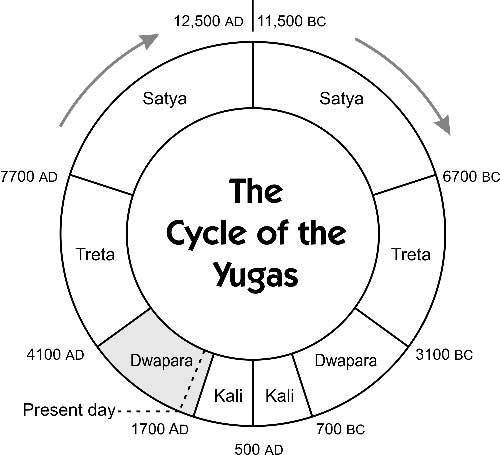Discussion Post I submitted for my Atlantic University TP5110 Course – November 18, 2020
Before diving into what consciousness might mean in Treta Yuga and Satya Yuga, it’s important to emphasize Joseph Selbie and David Steinmetz’s caveat when glancing forward from our current perch in Dwapara Yuga. In terms of perceiving treta consciousness, the authors note that we are like “children trying to comprehend the adult,” and regarding trying to comprehend satya consciousness, “we are like a child trying to understand a saint” (2010, p. 102 & p. 128).
As we get further into Dwapara, we’ll be able to comprehend that “everything is made up of ideas or thoughts” (2010, p. 102), and Treta Yuga advanced humans will now be able to use their thoughts to create “material object,” control “natural forces,” and share “thoughts directly with other people” (2010. p. 102). Without the need for learning through language, books, and other media, it will be much quicker in both the Treta and Satya Yugas as the student will be able to download a large amount of information nearly instantaneously. Another critical aspect of treta consciousness will be the ability to “overcome the limitations of time” (2010, p. 113). This will aid in healing, as people will be able to change their thoughts immediately instead of relying on slow-acting medical treatments, and humans may be capable of experiencing “the future and the past” as well as the present (2010, p. 113 & p. 114). Interestingly, while “self-interest” will still be present in Treta Yuga, “the right use of power” will be a primarily lesson as selfish use of power will ultimately “boomerang on the wielder” (p. 127).
While comprehending the Divine will be present in Treta Yuga, we will become Divine source and pure consciousness in Satya Yuga. “God is pure consciousness, beyond form and limitation, and our own consciousness, our very beings, is an inextricable expression of this consciousness” (2010, p. 129). While it gets nearly impossible to comprehend, hence the analogy of a child trying to understand a saint, we will gain direct intuitive perception, which will enable us to perceive God. Achieving this direct intuitive perception “will be the focus of development for Satya Yuga” (2010, p. 130 & 131). As the need for material objects dissipates, we will lead a simpler life focused on learning self-realization where the goal will be “to grow spiritually, rather than grow in wealth or position” as we do now. And we’ll have 400 years to do it! (2010, pp. 132-134). I found it challenging to comprehend how any conflicts could exist at either the Treta or Satya Yugas. Yet, it’s important to remember that there will exist “those whose awareness is more in tune with previous yugas” (2010, p. 137). That’s certainly the case when you examine the disparity in consciousness levels in our current world.
The movie Lucy comes to mind when considering both the Treta and Satya Yugas. In the film, the protagonist unavoidably ingests massive amounts of a new synthetic drug that, throughout the movie, allows her to use more and more of her brain until she reaches 100%. The film plays out as a timeline of her increasing mental/consciousness capacity. As she garners more and more, she goes through the states and capabilities described in the Treta and Satya Yugas, like reading people’s thoughts, manipulating material, and becoming closer and closer to Divine source (Besson, 2014).
Stories of Jesus, the saints, and other ascended masters help provide a path or direction forward. They are examples of how to live our lives in higher yugas, even though we may not be anywhere near their level yet. Jesus’s messages of laying your life down for another, turning the other cheek, and what he outlines in the Beatitudes are a blueprint for what Treta and Satya Yugas will bring. He delivered His teachings squarely amid Kali Yuga, which is why they crucified Him. Yet 2,000 years later they still can be used as a model to follow, along with those of Buddha, and many others who lived in higher states in this timeframe.
Like the Amish, there are those communities who attempt to live their lives as will occur in the higher yugas. It’s a tough time to attempt such a feat with the onslaught of non-stop media pushing divisive messages. Yet I know numerous people, and many at A.U., who are trying to lead simpler, more divinely connected lives. We’re on the cusp. It’s part of the Great Awakening, and it will take a while, but we’re getting there.
Because we’re nowhere near the end of Dwapara Yugas, the start of Treta Yuga won’t begin until 4,100 AD, and Satya Yuga another 3,600 beyond that, Wilber’s Second Tier does not extend out nearly far enough. He has his Yellow Meme starting roughly 50 years ago, and Turquoise, only 30 years ago. As someone alive during this period, I don’t share the optimism Wilber does regarding the progress our culture has made in that timeframe. Looking at the world’s landscape today, I see many ways where we’ve taken a considerable step backward in terms of fundamental civil rights, such as the freedom of speech, freedom of religion, and of course, freedom not to wear a mask! Treta and satya consciousness doesn’t have a goal of living as one worldly organism, as does Wilber (Mistlberger, n.d.). It has us returning to our Divine Source and becoming one with it. Wilber’s 2nd Tiers appear to be stuck in the early stages of ascending Dwapara Yuga, and in fact, he mentions very little if anything about the role of Divine source in stages of higher consciousness.
References
Besson, L. (Director). (2014). Lucy [Film]. EuropaCorp.
Selbie, J. & Steinmetz, D. (2010). “The yugas: keys to understanding our hidden past, emerging energy age, and enlightened future,” Nevada City, CA: Crystal Clarity Publishing.
Roemischer, J. (2002). “The never ending upward quest,” What is Enlightenment magazine, Fall/Winter( 22), 1-24. https://www.dailyevolver.com/wp-content/uploads/2012/11/spiraldynamics.pdf.
